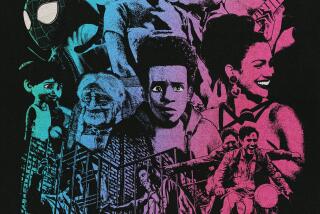FILM : Justice Finds a Place in Euzhan Palcy’s ‘Sugar Cane Alley’
“Sugar Cane Alley” has a redemptive purity about it. We watch a black boy escape from Martinique’s exploitative sugar cane fields and realize that life, however indifferent it seems, offers moments of justice.
Director Euzhan Palcy’s screenplay, based on Joseph Zobel’s influential 1950 novel of the same name, often simplifies Jose’s struggle and that of his people, the ghetto-dwellers who work on the white man’s plantations.
But that weakness doesn’t diminish the satisfaction that comes when Jose (Garry Cadenat) breaks away from the cycle they live in. “Sugar Cane Alley,” screening Friday night at UC Irvine as part of the Eclectic Flicks series, feels like a victory of righteousness.
The movie begins with a series of scenes with almost no specific point of view. It’s 1931, and cinematographer Dominique Chapuis’ camera follows the laborers and their children doing this and that, until our interest finally settles on Jose.
He’s a bright kid, obviously a leader of the ragtag youngsters who ramble through the dusty village getting into small troubles. Through them, Palcy informs us of a shanty life that mingles the past with the present, magic with hard reality. The kids mimic their parents, practicing junior-sized voodoo and spells to lessen the punishments the grown-ups invariably inflict.
Jose’s future appears different than that of the others: he’s able to act on the promise of his talents. We see him building relationships with his grandmother (veteran French actress Darling Legitimus), a woman of intense will, and, perhaps even more instrumental, with an ancient storyteller (Douta Seck) who guides Jose toward manhood.
The film’s crucial event comes when Jose’s ability to learn is recognized by school officials and he becomes the only village child accepted for classes in town. There, he begins to see his way out. It’s not an easy road, though, and Jose is tested almost at once. Still, his life is transformed from doubt into an epiphany of hope.
The film was hailed internationally after its release in 1983 as the first cinematic documentation of Martinique’s poor blacks, especially those who spend their lives cutting cane for small wages. Its faithful treatment of Zobel’s book, one of the earliest efforts to describe their predicament, was also applauded.
In Martinique, response to “Sugar Cane Alley” was thunderous. It was said that nearly half of the country’s entire population of 400,000 saw the movie in its first week, smashing the previous record of 40,000 that turned out for “E.T.” in 1982.
One report described the phenomenon this way: “The response was emotional and swept the range from laughter to tears. People remained in the theater for five and six screenings, walking from villages, hobbling on crutches; the sick were carried to the theaters from their beds by healthier relatives and friends.”
What: Euzhan Palcy’s “Sugar Cane Alley.”
When: Friday, Nov. 15, at 7 and 9 p.m.
Where: UC Irvine’s Student Center Crystal Cove Auditorium.
Whereabouts: Take the San Diego (405) Freeway to Jamboree Road and head south. Go east on Campus Drive to Bridge Road. Take Bridge Road into the campus.
Wherewithal: $2 to $4.
Where to Call: (714) 856-6379.
More to Read
Only good movies
Get the Indie Focus newsletter, Mark Olsen's weekly guide to the world of cinema.
You may occasionally receive promotional content from the Los Angeles Times.










